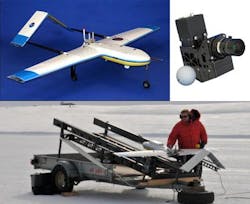Ocean and sea ice research project to use Headwall hyperspectral sensors
Spectral sensing and imaging company Headwall Photonics (Fitchburg, MA) delivered two high-performance hyperspectral imaging sensors to Columbia University (New York, NY) as part of its Air-Sea-Ice Physics and Biogeochemistry Experiment (ASIPBEX).
RELATED ARTICLE: Headwall granted USDA license for spectral poultry inspection
ASIPBEX is part of a larger international collaborative investigation of Climate Cryosphere Interaction with colleagues from Spain, Germany and Norway. This crucial remote-sensing project will use a high-endurance unmanned aircraft system (UAS) to investigate climatological changes present in the Arctic Ocean around Svalbard, Norway. The instrument payload comprises two Micro-Hyperpsec sensors; one will cover the Visible-Near-Infrared (VNIR) range of 400-1000nm while the other will cover the Near-Infrared (NIR) range of 900-1700nm. Together, the sensors will be crucial in detecting indicators of sea ice physics, solar warming and global carbon cycles.
"We chose the Headwall sensors for several reasons," stated Christopher Zappa, a Lamont Research Professor at Columbia's Lamont-Doherty Earth Observatory. "The very high resolution allows us to collect and process vast amounts of spectral and spatial data upon which our research and analysis depend." The wide field of view of the Headwall sensor combined with aberration-corrected optics also contributes to overall flight-path efficiency.
The UAS allows scientists to measure in places that typically are impossible to get to using ships or manned aircraft. This opens up the possibility for transformative understanding of the climate system. "Since we're using a UAS, we depend on 'seeing' as much of the ocean surface as possible, minimizing any aberrations or unwanted artifacts along the edges of the field of view," said professor Zappa. The combination of Micro-Hyperspec and Headwall's advanced Hyperspec III airborne software allows for the successful collection, classification, and interpretation of the spectral data collected during each flight.
"Hyperspectral represents a crucial payload for any manned or unmanned deployment," said Headwall CEO David Bannon. "But significantly notable is that the UAS has become a 'go-to' platform. This means not only smaller and lighter sensors, but also integrated solutions that factor in everything from LiDAR and data-management to post-processing tasks such as ortho-rectification that our software can handle." Because the Micro-Hyperspec sensor uses high efficiency diffraction gratings in a concentric, optical design, imaging performance and signal-to-noise are both maximized. The patented optical design provides a package that is rugged and robust for airborne use in harsh environments such as the Arctic ocean.
Led by Professor Christopher Zappa, the Observatory for Air-Sea Interaction Studies (OASIS) conducts research in a variety of fields focused on the oceanic and atmospheric boundary layers. These include wave dynamics and wave breaking, air-sea CO2 gas exchange, non-satellite remote sensing and boundary-layer processes. Affiliated with the Lamont-Doherty Earth Observatory (LDEO) and Columbia University, OASIS is involved in joint projects with the Polar Geophysics Group of LDEO, Yale University, the University of Heidelberg, the University of Connecticut, and the University of New South Wales and participated in various large multi-institution projects such as CBLAST-Low, GasEx, VOCALs, RaDyO, DYNAMO.
SOURCE: Headwall Photonics; http://www.headwallphotonics.com/press-releases/press-releases-blog/bid/356708/Headwall-Delivers-Micro-Hyperspec-Sensors-to-Columbia-University
About the Author

Gail Overton
Senior Editor (2004-2020)
Gail has more than 30 years of engineering, marketing, product management, and editorial experience in the photonics and optical communications industry. Before joining the staff at Laser Focus World in 2004, she held many product management and product marketing roles in the fiber-optics industry, most notably at Hughes (El Segundo, CA), GTE Labs (Waltham, MA), Corning (Corning, NY), Photon Kinetics (Beaverton, OR), and Newport Corporation (Irvine, CA). During her marketing career, Gail published articles in WDM Solutions and Sensors magazine and traveled internationally to conduct product and sales training. Gail received her BS degree in physics, with an emphasis in optics, from San Diego State University in San Diego, CA in May 1986.
